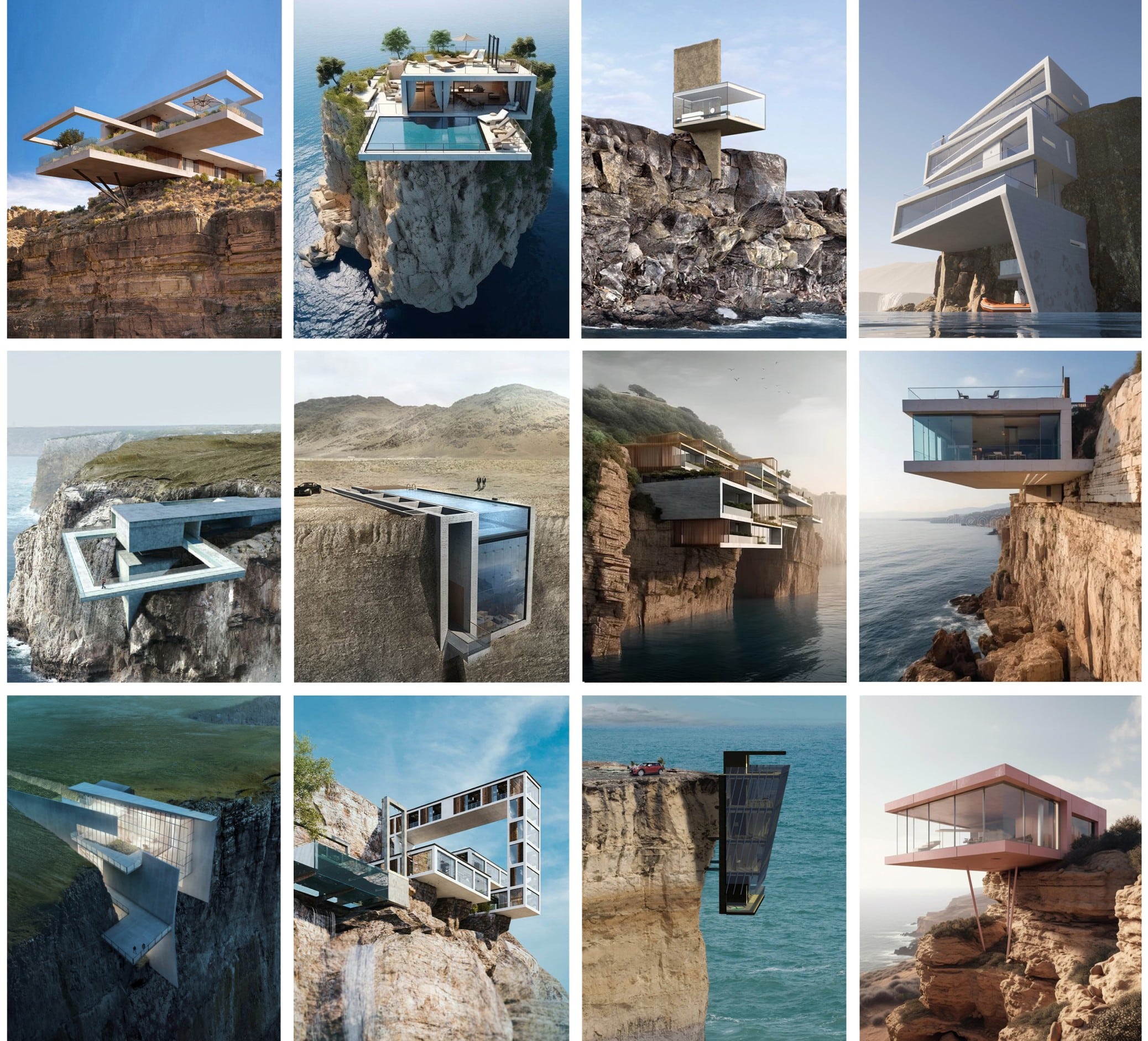
Houses-drones and landscapes-trophies
In the artefact-saturated digital universe, publicity often reveals some converging approaches.
For example, images of fantastic cliff houses, i.e. houses on cliffs, usually above the sea, are increasingly appearing on the internet. It is not always clear whether these are elaborate architectural proposals, simple design exercises, or images resulting from commands to Midjourney’s algorithms or other artificial intelligence. In each case, there is a design intent that consciously shapes or even guides the outcome. An intention repeated and therefore indicative of some greater impulse.
Even if these works are fantasies and displays of eccentricity, their common features reveal something about the dispositions of the new architects and their respective audiences.
They reveal to us in principle a strange desire to inhabit the extreme limits. These houses avoid the safety of standing on level or sloping ground, but rest on the brow of the cliff or even on its vertical sides. Entire volumes, rooms, terraces and swimming pools are suspended above the void, making a sometimes convincing and sometimes outrageous use of the cantilever. And this is clearly not done just for the unobstructed view or the isolation. An almost unheard of problem appears in these houses, which is the terrifying sensation of vertigo. Retreating into the serenity of nature seems not to be enough, and the habitation must additionally be intoxicated by the adrenaline of danger and the brazen defiance of gravity.
All this would remain at the indifferent level of a paradox (or an unwarranted misreading of F. L. Wright’s Fallingwater) if it did not enjoy internet popularity. So for what reasons does this extremity tend to emerge as an architectural or cultural fetish?
The anxious search for originality does not in itself provide a satisfactory explanation. Nor is it certain that impressionism is employed only as a narcissistic baiting of potential customers. Along with these I think also the fact that the steep borders are now showing as attractive places to settle. It seems that for some, living in the countryside is only acceptable if it takes the form of a radical extremity.
In other words, it should be done with extreme constructions and in extreme locations. To fuel a constant sensory overstimulation. But not the emotional arousal that results from a mystagogic immersion in the wonders of nature, but the kind of physical and perceptual tension that comes from acrobatics at topographical boundaries.
Many factors have contributed to the formation of such an attitude. A role is played, for example, by the jerky movement and constant undermining of balance that video games and extreme sports have made us familiar with. For many, an almost compulsive association of the countryside with speed and adrenaline has been established.
Still, our addiction to the visuals offered by drone cameras should not be underestimated. The hovering of the gaze in the air and the vertical viewing of drones have evolved into an ingrained way of relating to our environment. And this mediated perception inadvertently becomes a norm for the way architecture attempts to place us within the world. In this way, the precarious suspension of the building in the void acquires a fictitious validity. And just like that, the mental oxygenation of nature and the open horizon slip into the need for visual surprise and a taste of vertigo.
Of course, it is not very difficult to establish that such groundbreaking architectural choices remain ideologically vague. Their visionary character is limited to the level of spectacle, without opening any perspective of transcendence or rupture with hegemonic standards and symbolic systems. The choice of inconvenient location and marginal support does not attempt to critically metabolise the ontological sense of exile that accompanies our life in the postmodern world. Nor does it attempt to derail the social meanings of habitation outside of market real estate formulas.
On the contrary, in cliff houses all the conformity and established codes of the country villa remain intact. The prevailing logic of the sterile urban apartment landing in the countryside is perpetuated. Simply, the stereotypes of a blissful lifestyle are enriched with additional benefits: with the immediacy of the view and with the technical bravura of the canopies.
Thus, these proposals are coordinated with a large part of modern residential architecture, which in every possible way opposes the low tones and the purifying and liberating character of living in the countryside. Where their phantasmagoria betrays a mental panic in front of the slowness of the holiday experience and the mysterious silent interiority of its spaces. And which on the contrary suggest a habitation which is given meaning only by voyeuristic surprises, by tensions that excite neurotransmitters and extort intense emotion.
Finally, the unproblematic placement of these country houses in the most untouched and inaccessible landscapes is equally problematic. If the uncontrolled construction of the countryside has developed into something deeply problematic, in the specific cases we have a more specific pathogenesis. The presence of these buildings has an impermissibly polluting character, as it blatantly imposes itself on the edges and transitions of the topographic relief. No matter how skilfully the constructions are tied to the rocks, no matter how romantic they look in the wilderness of the steep coast, they interfere precisely with the limbic boundaries with which the eye assembles the essence of the landscape.
I remember an old prediction, something like an unwritten law, that forbade building on the neck of the hills due to the alteration of their natural ridge. Such sensitivities seem to have passed. After all, with the cancerous spread of tourist infrastructure and the vandalism of mountain ridges by industrial wind turbines, the visual pollution of the landscape has become established as a cornerstone investment right.
And unfortunately, cliff houses use their visual allure to validate the perception of the landscape as a trophy of an egotistical conquering obsession.
Kostas Manolidis
Professor at the University of Thessaly
Source: https://www.archetype.gr
